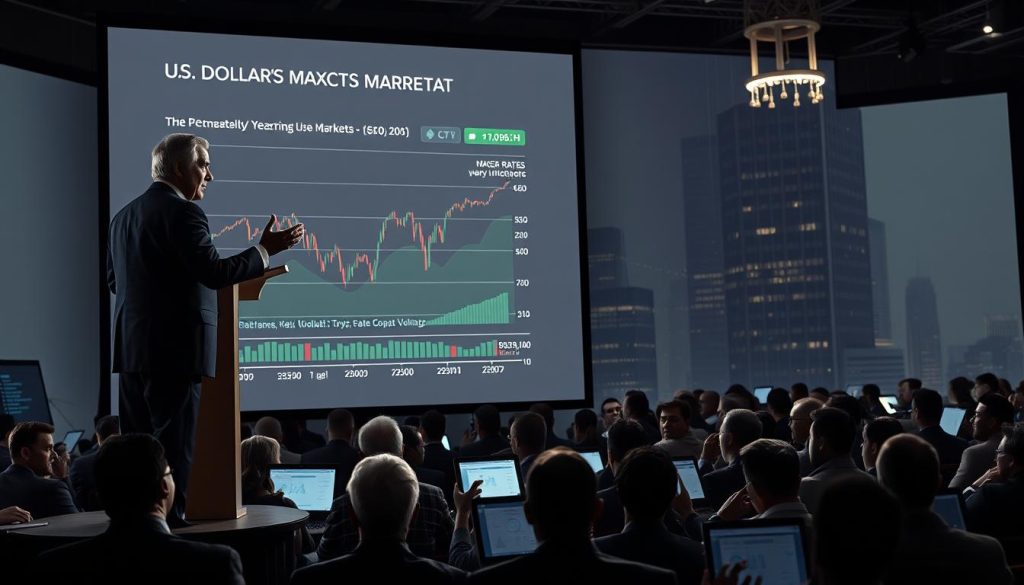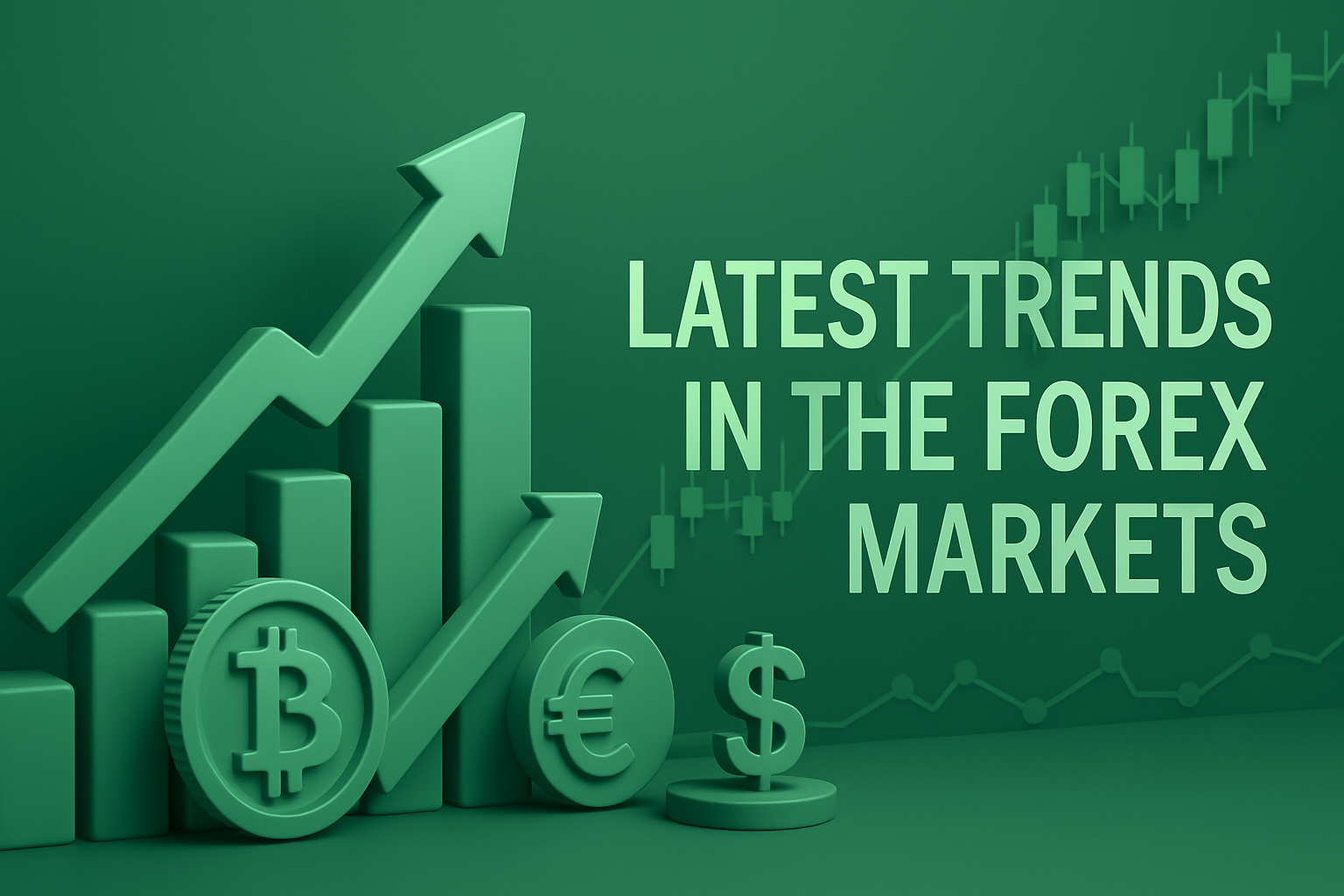This report opens with a clear market snapshot for the year. It shows how policy headlines, central bank communication and AI are reshaping pricing, execution and risk across the exchange ecosystem worldwide.
The note highlights concrete shifts: CME vendor tie-ups that change liquidity paths, model-driven pricing using Llama 3.1, and execution studies that find 4pm hedging can cut costs by up to 25%.
Traders see USD softness, thin liquidity episodes and headline risk as core drivers. Data-led workflows and infrastructure upgrades explain why steady growth persists despite uncertainty.
Readers will get a structured view: short-term conditions, macro policy impact, AI’s practical edge, venue access changes, and multi-year growth projections that guide trade and risk decisions.
Key Takeaways
- Policy moves and court rulings now move price and flow rapidly.
- AI and predictive pricing are improving execution and signal quality.
- Connectivity shifts at CME broaden access to primary venues.
- Data-led trading supports resiliency and steady industry growth.
- Practical hedging timing can reduce transaction costs materially.
Present market snapshot: USD softness, thin liquidity, and headline risk
Markets began September with the US dollar under pressure, letting the euro gain ground during thin holiday flows. EUR/USD peaked at 1.1736 in European trade and held above the 1.1700 handle as activity stayed muted.
U.S. Labor Day and Canada’s market holiday cut participation, leaving liquidity light until Asia’s open. Low volume can amplify short-term volatility and widen spreads, so execution costs rise for those who trade during off-peak hours.
The euro also picked up a mild data tailwind after EU unemployment fell to 6.2% from 6.3%. That improvement gives modest support to EUR sentiment while market participants await ECB remarks from Christine Lagarde, which could alter rates expectations and near-term crosses.
Practical takeaways for traders
- EUR favored as the usd trades softer; EUR/USD keeping the 1.1700 area signals restrained dollar momentum.
- Thin liquidity from holidays can amplify volatility and widen spreads; use measured sizing and staggered entries.
- Headline sensitivity is high—firm data checkpoints and liquidity-aware execution help manage event risk.
| Metric | Value / Impact | Action |
|---|---|---|
| EUR/USD intraday high | 1.1736 — held >1.1700 | Consider smaller, staggered entries |
| Liquidity | Thin until Asia open | Avoid large resting orders; favor liquidity-aware routing |
| EU unemployment | 6.2% (July) — mild euro support | Monitor Lagarde for rates guidance |
Policy and macro drivers shaping the dollar and volatility
Rising effective tariffs and legal uncertainty are tightening risk premia and altering dollar dynamics as policy windows approach.
Fitch cut its U.S. GDP forecast for 2025–2026 to 2.2%, citing higher effective tariffs near 15–20% versus about 2.5% a year earlier. Oxford Economics estimates roughly a $1 trillion drag on global GDP over two years.
Those shifts change trade flows and create second-order pricing pressures that ripple into currency and rates markets. A recent U.S. court found most reciprocal tariffs unlawful but paused the ruling until October 14, keeping policy ambiguity alive.

Positioning and event risk
Hedge funds bought short-dated, high-delta and far‑OTM “lottery” FX options ahead of Jackson Hole and Fed remarks. That activity signals hedging demand and a selective bearish tilt on the dollar even as spot moves stay mixed.
- Impact: Tariffs and rulings lift headline volatility and can widen spreads during data or policy releases.
- Action: Banks and buy-side desks should merge options flow with spot liquidity reads to calibrate trade sizing and timing.
- Cross-currents: ECB messaging and EU unemployment at 6.2% may offset or amplify USD moves depending on any hawkish or dovish nuance from Lagarde.
| Driver | Data / Signal | Trading impact |
|---|---|---|
| Tariffs | 15–20% effective rates | Reshapes trade flows, raises inflation risks |
| Legal rulings | Ruling paused to Oct 14 | Keeps policy uncertainty and risk premia elevated |
| Options flow | Lottery buys pre-policy events | Signals hedging, possible near-term dollar softness |
AI and data in focus: how language models and predictive pricing are redefining FX
New model-driven workflows let traders extract tradeable currency signals from unstructured news feeds. Meta’s Llama 3.1 ranked top at predicting G10 currency sentiment from news, turning headlines into timely inputs for price makers.

Banks are operationalizing predictive pricing to tighten spreads and improve fills for trading clients while keeping risk controls intact. Quant teams pair LLM outputs with microstructure data to model execution impact and choose venues dynamically.
Llama 3.1 leads sentiment prediction
“State-of-the-art models convert raw news into signals that move order books,” industry tests show.
Practical benefits and evidence
Four‑pm benchmark simulations found that measured, paced hedging — a “slow and steady” approach — cut costs by up to 25%. During tariff-driven episodes, lit spot and futures books offered consistent, actionable pricing and clearer audit trails.
- Models reduce slippage via dynamic scheduling.
- Pre- and post-trade analytics quantify impact and guide refinements.
- Services must address model drift, regime shifts, and data latency to keep outputs aligned with exchange behavior.
Liquidity, access, and market structure: evolving venues and bilateral trading
Vendor integrations at major venues are reshaping how participants find and route flow across venue and bilateral channels.
CME vendor tie-ups and venue access
CME’s partnerships with Trading Technologies and Integral expand direct access to EBS and Spot+. This channels more flow into primary order books and can tighten spreads for many participants.
Benefit: deeper price discovery and clearer execution paths for firms that prioritize exchange-based liquidity.
Crypto follows an OTC-like path
Institutional crypto trading is shifting from central limit books toward bilateral workflows. Firms prefer tailored credit, counterparty selection, and flexible settlement that mirror OTC FX.
BridgePort and other providers report bilateral demand is a major driver for institutional adoption.
Dealer dynamics and client segmentation
HSBC and Goldman Sachs performed well with U.S. retail funds, while Morgan Stanley retained strength with life insurers. This shows how banks segment services by client type.
- Primary venues anchor firm quotes for immediate fills.
- Bilateral channels offer bespoke execution for large or sensitive orders.
- Consistent connectivity, smart order routing, and post-trade data are prerequisites to capture these venue advantages.
| Feature | Impact | Trader action |
|---|---|---|
| Vendor integrations (CME + partners) | Reroutes flow to EBS and Spot+ | Evaluate direct connectivity; prioritize venue-enabled routing |
| Crypto bilateral demand | OTC-style credit and settlement options | Map counterparty credit and prefer bilateral desks for size |
| Dealer segmentation | Specialized coverage by client type | Match bank services to strategy archetype |
Latest trends in the forex markets: growth outlook, segmentation, and platforms
The projected USD 582B expansion to 2029 reframes where firms allocate engineering and sales effort. Technavio’s report sets a 10.6% CAGR baseline that helps firms plan capacity, platform builds, and product rollouts year over year.
Market growth trajectory and planning
Quantifying growth at +USD 582B through 2029 gives a clear signal for budget cycles. Teams can tie roadmaps to a measurable market and justify staged investments in latency, analytics, and compliance.
Participant segmentation
Reporting dealers, financial institutions, and non‑financial customers each shape liquidity and service models. Dealers anchor price discovery; institutions demand robust data and risk tools; corporates favor tailored hedges and simple workflows.
Instrument and platform mix
Usage spans currency swaps, outright forwards and FX swaps, and FX options. Platform choice—electronic, OTC, and mobile—drives spread capture, latency needs, and client onboarding paths. U.S. traders see mobile and electronic venues as growth opportunities.
Drivers, challenges, and AI impact
AI and better data pipelines help firms personalize pricing and document execution in formal reports. Governance, model risk, and uneven data quality remain core challenges.
“The industry must balance rapid innovation with rigorous controls to scale responsibly.”
Practical takeaway: align investment to expected market growth, match platform choice to client type, and embed governance for AI to turn capacity into competitive advantage.
How Brokers Support AI-Driven FX Trading: The Case of fxnx
As the FX market integrates AI workflows, predictive pricing, and liquidity-aware execution, traders increasingly need brokers that can align with these innovations. fxnx provides an institutional-grade environment where data, execution, and compliance converge.
fxnx Features Relevant to Current FX Trends
- NX One® Zero-Spread Accounts: Minimize transaction costs, especially important in thin-liquidity episodes or high-frequency execution.
- AI-Enabled Tools (NX AI Market Predictor & Trading Assistant): Mirror the broader trend of LLM-driven signal extraction by helping traders anticipate flows and manage execution timing.
- Professional Platforms (MetaTrader 5 & cTrader): Integrated with advanced charting and APIs, allowing quants to test “slow-and-steady” hedging and algorithmic execution strategies.
- Multi-Asset Access (Forex + Crypto): Lets traders diversify execution across FX and digital assets — useful in an era where OTC-style bilateral structures are converging across asset classes.
- Regulated & Transparent: Operating under Saint Lucia FSRA (License 2025-00128), fxnx aligns with the market’s demand for compliant and auditable venues.
Why This Matters
When traders face USD softness, headline-driven volatility, or CME connectivity shifts, brokers like fxnx provide the infrastructure to:
- reduce slippage via smarter execution tools,
- route orders to liquid venues efficiently,
- and balance innovation with transparency.
fxnx illustrates how a broker can serve as a practical bridge between cutting-edge AI models and the day-to-day needs of traders in global FX markets.
Conclusion
This year tested execution and risk frameworks as policy noise, episodic liquidity, and AI adoption reshaped behavior across the market. Traders navigated usd softness, headline-driven moves, and pockets of elevated volatility with tighter sizing and clearer timing.
Banks and buy-side firms leaned on better data and model-led pricing to reduce market impact and improve benchmark fills. Venue upgrades and CME tie-ups widened access, giving teams optional paths for immediacy, spread capture, or information control.
With disciplined prep and diversified workflows, traders can manage event risk and capture opportunities. Continued investment in tech, governance, and strategy should keep growth on course through 2029 and amplify positive impact for firms that align tools with client needs.
FAQ
What is driving current USD softness and thin liquidity?
The dollar’s weakness reflects a mix of muted U.S. flow, lighter summer trading, and headline risk from policy and legal developments. Reduced institutional activity around holidays and lower participation from hedge funds and corporate flows thin liquidity, amplifying moves on macro headlines and central bank comments.
Why did EUR/USD remain above 1.1700 during the U.S. Labor Day period?
EUR/USD held firm as U.S. volume waned while European data and ECB communication provided support. With fewer dollar-demand flows and light positioning by speculators, minor news pushed the pair, and traders refrained from aggressive directional bets ahead of key U.S. releases.
How do tariffs and legal uncertainty affect U.S. GDP forecasts and exchange rates?
Tariff policy and court decisions raise uncertainty for trade and investment, prompting agencies like Fitch to cut growth projections. That outlook weakens risk appetite and can put downward pressure on the dollar if growth and rate expectations shift, while increasing currency volatility across traded pairs.
What are traders’ common positioning strategies around Fed and Jackson Hole events?
Traders often reduce directional exposure and buy option structures resembling “lottery” bets that profit from sharp moves. Many prefer short-dated options or hedge with calendar spreads, aiming to capture volatility spikes while limiting carry costs during major central bank events.
How does ECB communication and EU labor data influence USD/EUR dynamics?
Clearer ECB guidance or stronger EU labor metrics can tighten euro rate expectations, supporting the euro versus the dollar. Conversely, dovish signals or weak employment prints soften the euro. Cross-currents arise when U.S. policy cues diverge, creating trading opportunities and elevated short-term volatility.
What role are AI models playing in currency sentiment and price prediction?
Large language models and specialized machine learning systems now extract sentiment from newsflow and social data to forecast short-term currency moves. These models help pricing desks anticipate order flow, inform predictive spreads, and support execution algorithms that seek better fills.
Which banks are advancing predictive pricing and execution tools?
Major global banks are embedding predictive pricing into execution venues to tighten spreads and improve fills. Institutions focused on U.S. asset managers and insurers combine historical liquidity patterns with real-time signals to calibrate quotes and reduce market impact for clients.
How do quants use LLMs to reduce slippage and estimate market impact?
Quant teams feed LLM-derived features into impact models that consider news, orderbook imbalances, and time-of-day effects. That enhances execution scheduling, enabling algorithms to slice flows and limit slippage by anticipating where and when liquidity will appear.
What evidence supports “slow and steady” hedging to cut costs at the 4pm benchmark?
Simulation studies of benchmark hedging show that staggered execution and adaptive algorithms reduce adverse price moves. Results indicate that slower, liquidity-aware execution can trim transaction costs by substantial margins in volatile windows compared with aggressive lump-sum fills.
How has tariff turmoil affected pricing in spot and futures books?
Tariff-driven uncertainty widened bid-offer spreads and increased dispersion between spot and futures books. Market participants seeking consistent, actionable pricing shifted toward deeper venue pools and trusted counterparties, while some electronic platforms tightened execution standards to regain flow.
How are venue changes affecting liquidity and trading access?
Expanded connectivity from exchanges such as CME via technology providers channels additional flow into major liquidity pools, improving depth for institutional users. Broader access encourages competition among venues and can lower execution costs for large orders when routed intelligently.
In what ways is crypto trading mirroring traditional FX market structure?
Over-the-counter bilateral demand in crypto resembles institutional FX, with large counterparties arranging bespoke blocks off-exchange. This OTC-like path concentrates liquidity with major dealers and prime brokers, affecting price discovery and settlement practices similar to classic FX markets.
Which dealers lead across client segments and why does that matter?
Some global banks excel with specific client types—certain firms perform strongly with U.S. funds while others serve insurers and corporates more effectively. Dealer strengths shape access to liquidity, tailored pricing, and the quality of execution available to different market participants.
What is the projected market growth and key drivers through 2029?
Industry forecasts point to robust expansion driven by rising cross-border trade, increased electronic adoption, and demand for hedging solutions. Growth is supported by innovation in platforms and services, with AI and improved data analytics fueling differentiation and adoption.
How does market segmentation by participant, instrument, and platform affect trading strategy?
Different participants favor specific instruments and venues: reporting dealers and financial institutions dominate swaps and OTC products, while non-financial customers use forwards and options for risk management. Electronic platforms and mobile access reshape execution tactics, so traders choose tools that match their size and urgency.
What challenges limit broader adoption of AI-driven FX solutions?
Barriers include data quality, model interpretability, and integration with existing execution systems. Firms must manage regulatory expectations, oversee model risk, and ensure AI outputs translate into actionable pricing without introducing unintended market distortions.
How should traders approach volatility and headline risk going forward?
Traders should emphasize liquidity-aware execution, diversify venue access, and use options to hedge tail risk. Maintaining adaptive positions and leveraging predictive analytics helps navigate sudden shifts caused by policy announcements, data surprises, or legal rulings.
